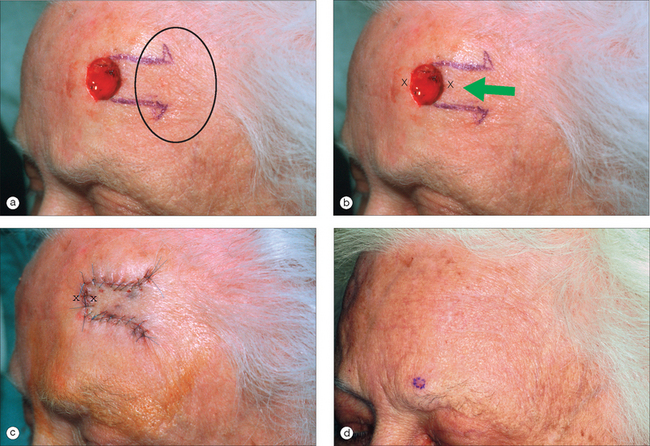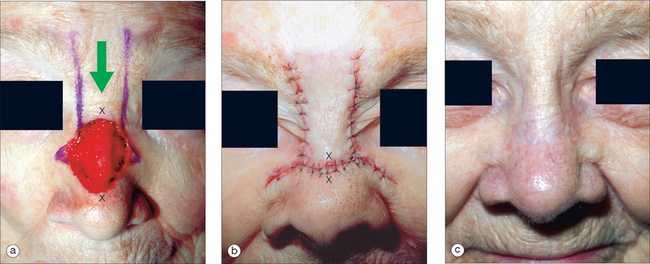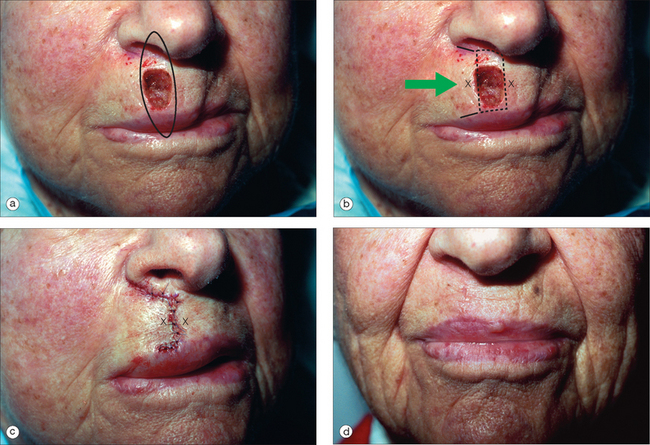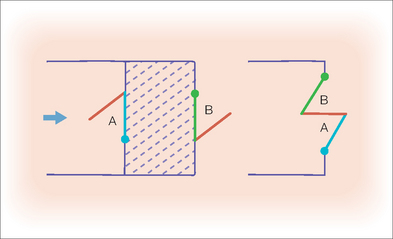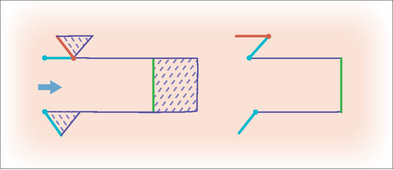Chapter 4 Advancement Flaps
FLAP DESIGN AND CONSIDERATIONS
Aulius Cornelius Celsus wrote his 21-volume medical textbook, De Re Medicina Libri Octi, almost 2000 years ago. In it he described a method for repairing “mutilations” of the ear, lips, and nose that is still in use today, the advancement flap:
The method of treatment is as follows: the mutilation is enclosed in a square; from the inner angles of this, incisions are made across, so that the part on one side of the quadrilateral is completely separated from that on the opposite side. Then the two flaps, which have been freed are brought together.1
Clearly not a recent innovation, the advancement flap can be thought of as a sliding flap that moves along a single vector directly into the surgical defect (Figure 4.1). Once the defect is closed, the surrounding tissue provides the secondary movement or opposing force.2 The flap is designed by extending parallel incisions (not necessarily of the same length) from one side of a surgical defect. Since the flap is created from adjacent skin, one edge of the defect becomes the advancing tip of the flap. This basic design has also been called a U-plasty or rectangular flap. The prominent horizontal lines make the advancement flap particularly useful in the reconstruction of the eyebrow and forehead areas. It can also be effective for reconstruction of defects on the upper lip, dorsal nose, and helical rim.
The primary advantage of an advancement flap lies in its ability to redistribute standing cones (dog-ears) to a more favorable location that is not necessarily contiguous with the defect. When a circular wound is closed with a linear side-to-side closure, standing cones develop adjacent to the superior and inferior apices. In both rotation and transposition flaps, a standing cone develops at the pivotal base where it must be excised to allow for full movement of the flap.3 The geometry of an advancement flap allows for excision of tissue redundancy anywhere along the length of the flap. In this way the incisions can be hidden within relaxed skin tension lines (RSTLs) or cosmetic unit junction lines (Figure 4.2).
There are several factors that must be taken into account when designing an advancement flap. The most important consideration is the amount of tissue laxity available for closure of the defect. An advancement flap does not lower the tension of closure much beyond that which can be achieved with a side-to-side closure and it is not a good choice for large defects without surrounding laxity. With experience, the surgeon can estimate the degree of tissue mobility and identify tissue reservoirs by pinching and stretching the defect and surrounding skin. The physical manipulation of tissue to estimate mobility cannot be stressed enough. Once the flap is incised from the surrounding tissue, it relies on the blood supply within its pedicle to maintain viability. The flap’s perfusion is determined largely by its dimensions, the quality of the vasculature within its pedicle, and the tension placed upon it during closure.4 Blood flow to the tip of the flap is inversely related to the tension of wound closure and even a wide, well-perfused flap is at risk for necrosis if placed under too much strain.5
Figure 4.3 demonstrates some of the fundamental considerations of flap design, which include sufficient tissue laxity to allow for tension-free closure, no distortion of free margins, placement of incision lines in cosmetic junction lines, and reliable flap perfusion. In this case, by pinching the defect and surrounding skin, the surgeon was able to identify the melolabial fold as an available tissue reservoir and the lip as the free margin at highest risk for distortion. There was sufficient laxity to permit a horizontal side-to-side closure but this would have created standing cones that extended into the nostril and across the vermilion. Instead, an advancement flap that displaced the standing cones laterally instead of vertically was designed. The tension vector was oriented parallel to the free margin of the lip to minimize any distortion. The flap had a wide, tension-free pedicle that increased the likelihood of an adequate blood supply. Of note is that the defect was enlarged slightly to allow for placement of the incisions along cosmetic junction lines. Generally, the width of an advancement flap is determined by the height of the defect but in select circumstances, the surgeon may consider widening the defect to allow for better camouflage of incision lines and a more aesthetic outcome.6 If desired, a Z-plasty may be incorporated into the leading edge of the advancement flap to further decrease the risk for upward pull on the lip with scar contraction (Figure 4.4). This modification not only widens the flap tip, but also breaks up and partially redirects the scar line along which some contraction will occur during wound healing.
FLAP MOBILIZATION AND KEY SUTURES
Once the flap design has been determined, the proposed incision lines should be marked on the skin prior to infiltrating additional local anesthesia. This allows for more accurate placement without distortion by tumescence. To ensure symmetry, these markings should be confirmed with the patient in the upright position. After local anesthesia is achieved, the surgical defect may be undermined in all directions prior to incising the flap. This allows the surgeon to assess the degree of tissue laxity and to reconfirm the surgical plan. It is wise to approach each reconstruction with several alternatives in mind, recognizing that intraoperative adjustments in the surgical plan may be necessary. For example, there are times when unexpected laxity may allow for a less complex closure with comparable cosmesis and lower morbidity. Conversely, there may be less movement than expected requiring flap modification. The potential for either scenario always exists and it is best to have considered all potential outcomes before starting any surgical procedure. It is usually helpful to make incisions that keep the most options available first, and save those that lock into a particular closure for last.
The classic advancement flap is designed for a rectangular defect but it is not always necessary to square the edges of a circular defect prior to incising the flap.7 In fact, it may be prudent to wait until the flap has been mobilized to evaluate whether the recipient defect should be modified or the flap tip rounded. Since flap viability is directly related to the width of the pedicle and not the shape of the flap distal to it, the surgeon is free to choose the option that achieves the best aesthetic result.4
The final length of the flap will depend upon the width of the pedicle, anatomic location of the defect, and adjacent skin laxity. In general, the maximum length for a random pattern flap on the face is limited to 3–4 times the width of the pedicle.8 The surgeon may consider making the initial incisions slightly shorter than were originally designed to accommodate unexpected laxity discovered after undermining. These incisions can always be extended if additional length is needed. The flap should be thick enough to fill the defect and include the subdermal vascular plexus with at least a portion of the upper subcutaneous fat. In the absence of vital anatomic structures, the flap should become progressively thicker as it extends towards the base of the pedicle. This allows for larger caliber vessels to be recruited and may increase the likelihood of flap survival. If there is a question of sufficient blood supply, it may be appropriate to deepen the defect to accommodate a thicker flap with more robust perfusion.
In an advancement flap, the entire flap and surrounding skin should be undermined in all directions. This increases mobility, distributes tension more evenly, and, by spreading out the forces of contracture that will occur during wound healing, may limit the development of pincushioning.9 The exact undermining depth will vary with the location of the defect.10 In anatomic danger zones, such as over the zygoma and mandible and within the posterior triangle of the neck, the dissection must remain in the upper subcutaneous fat and above motor nerves, or permanent functional loss may result. Small defects on the forehead can be undermined in the subcutaneous fat above the frontalis fascia. However, large forehead defects are best dissected in the subgaleal plane. In hair-bearing locations such as the eyebrow, the undermining should be well into the subcutis and deep to the hair papillae. The nose should be undermined in the submuscular plane and the ears above the perichondrium. Once undermining has been performed, the flap is pulled gently into the defect to test its mobility. If this maneuver produces excessive tension, the most common cause is insufficient undermining. If tension remains despite wide undermining, the surgeon may consider lengthening the flap or converting it into a bilateral advancement flap to obtain additional tissue movement.11
By design, an advancement flap has skin edges of unequal lengths and closure of the primary defect almost always creates tissue redundancies along the outer edges of the surrounding skin. In most cases it is best to wait until the flap has been undermined and the primary defect closed before excising the standing cones, as tissue stretch and accommodation often leave them smaller than were expected preoperatively. Not infre-quently, the redundant tissue may be distributed by the “rule of halves” and will not require excision at all (Figure 4.3).12 If excision is necessary, one common method is to remove the standing cones as Burow’s triangles. These triangular cones can be excised at the base of the flap to create a flared or “hockey stick-shaped” suture line (Figure 4.1). Alternatively, in advancement flaps, they may be placed at any point along the skin edge (Figure 4.2). The traditional Burow’s triangle is oriented with its base placed along the wound edge and apex pointing away from the flap but may be inverted if a zigzag suture line is desired (Figure 4.5). This maneuver lengthens the overall suture line but may decrease the extent of contraction and in certain instances be more inconspicuous than a linear scar.13
FLAP MODIFICATIONS AND APPLICATIONS
H-plasty or Bilateral Advancement Flap
In the H-plasty or bilateral advancement or rectangular flap, parallel incisions are created on opposite sides of the defect. The two limbs of the flap are then advanced centrally to form an H-shaped suture line (Figure 4.6). This flap is most useful for locations with prominent horizontal lines such as the forehead, eyebrow, or glabella. The incision lines do not need to be exactly parallel and may be curved to conform to RSTLs. The advantage of an H-plasty is that each flap must advance only half as far as the single flap design. It is used in situations where a unilateral flap will not provide adequate tissue for tension-free wound closure.14

